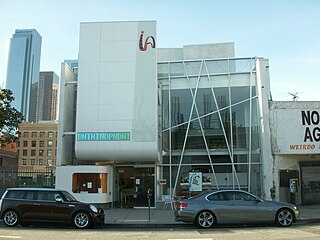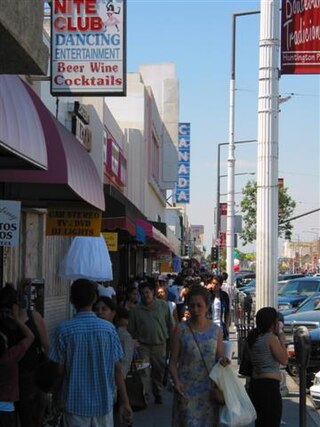The Pussycat Theaters were a chain of adult movie theaters, operating between the 1960s and the 1980s. Pussycat Theaters had 30 locations in California and were known for their cat-girl logo. The last one closed in 2022.
The Pussycat Theaters were a chain of adult movie theaters, operating between the 1960s and the 1980s. Pussycat Theaters had 30 locations in California and were known for their cat-girl logo. The last one closed in 2022.
David F. Friedman and Dan Sonney [1] founded Pussycat Theaters. Dan Sonney invented the name, based on Woody Allen film What's New Pussycat . Friedman has also cited the Pink Pussycat burlesque club on Santa Monica Boulevard as having previously established the word "pussycat" in relation to "pink" porn, since the early 1960s. The first Pussycat Theater opened in March 1966 on 444 South Hill Street, Los Angeles. Within two years, there were almost a dozen locations, from San Diego to San Francisco. [2] [3] [4] [5]
In 1968, Vince Miranda [6] bought a 50% share of the company. Miranda was unable to prevent those outside California from using the Pussycat name. Miranda spent $1 million to improve the decor of the theaters. They were known for being cleaner and fancier than other such places. The interiors featured red and gold carpeting, velveteen fixtures, beveled glass, mirror walls, chandeliers, oil paintings, murals, and merchandise bearing the Pussycat logo. Some Pussycat theaters sold popcorn from the box office to pedestrians on the sidewalk, with no obligation to buy a ticket. [7] [8] [9]
Vince Miranda and George Tate (who were lovers) shared ownership of Walnut Properties, the company that owned the Pussycat Theaters. Miranda may have had exclusive California license to show Deep Throat , a hugely lucrative film. His main competitors were the Mitchell brothers in San Francisco. [10]
Residents who lived near the theaters complained to the city governments that children could see the images of women on posters, ads, and cardboard stand-ups. Community members wanted the theaters to close. The citizens groups and government sued Walnut Properties under a variety of laws, including obscenity, public nuisance, rezoning, eminent domain, The Red Light Abatement Act, and the US Supreme Court's "preponderance" redefinition of porn theaters. Walnut Properties was served with over 100 civil lawsuits filed between 1973 and 2005. Between 1977 and 1994, at the Pussycat Theater in Santa Monica, "the Los Angeles Police Department made 2000 arrests for lewd conduct on the premises." In 1981, an ordinance was passed banning adult movie theaters in Santa Monica. [11] [12] [13] [14] [15]
In 1983, pornographic videotape sales began to compete with adult theaters, reducing theater attendance. At the age of 52, Vince Miranda died of complications related to cancer in 1985. George Tate and his new paramour Jonathan Cota inherited Walnut and the Pussycat Theaters. The IRS imposed a federal tax lien of $6,047,760 on Miranda's estate. The theaters were losing money fast. Many theaters are given to debtors in lieu of money, and/or converted to general admission theaters. [16]
By 1990, fewer than 20 California Pussycats remained, and by 1992, only a dozen were still open. In 1994, Walnut Properties filed for bankruptcy, claiming liabilities of $17.7 million. George Tate spent all the money and died the same year. Jonathan Cota inherited Walnut and its debts. [17] [18] [19] [20] [21] [22] [23] [24] [25] [26] [27] [28] [29] [30] [31] [32] [33] [34] [35] [36] [37] [38] [39] [40]
By 2003, all the theaters were gone except one at 7734 Santa Monica Boulevard in West Hollywood. Filmmaker Roger Corman saved the last Pussycat Theater by brokering a deal with an unnamed buyer. In 2004, Cota threatened to file a lawsuit against the Pussycat Dolls, for trademark infringement on the Pussycat name. The U.S. Patent and Trademark Office ruled that the Pussycat had abandoned the trademark, and the case was dismissed. The last remaining Pussycat Theater showed homosexual pornography. The name was changed to the Tomkat, then to Studs. It went out of business on October 29, 2022. [41]

The Cinerama Dome is a movie theater located at 6360 Sunset Boulevard in Hollywood, California. Designed to exhibit widescreen Cinerama films, it opened November 7, 1963. The original developer was William R. Forman, founder of Pacific Theatres. The Cinerama Dome continued as a leading first-run theater, most recently as part of the ArcLight Hollywood complex, until it closed temporarily in March 2020 due to the COVID-19 pandemic in California. The ArcLight chain closed permanently in April 2021, with the theater never having reopened. In June 2022, it was announced that there were plans to reopen it and the former ArcLight Hollywood under a new name, Cinerama Hollywood.

A grindhouse or action house is an American term for a theatre that mainly shows low-budget horror, splatter, and exploitation films for adults. According to historian David Church, this theater type was named after the "grind policy", a film-programming strategy dating back to the early 1920s which continuously showed films at cut-rate ticket prices that typically rose over the course of each day. This exhibition practice was markedly different from the era's more common practice of fewer shows per day and graduated pricing for different seating sections in large urban theatres, which were typically studio-owned.

Fox Theatres was a large chain of movie theaters in the United States dating from the 1920s either built by Fox Film studio owner William Fox, or subsequently merged in 1929 by Fox with the West Coast Theatres chain, to form the Fox West Coast Theatres chain. Fox West Coast went into bankruptcy and was sold to The National Theatres Corporation, led by Charles Skouras, on November 19, 1934, for $17,000,000.00. Eugene Klein later became CEO of National, and turned it into the conglomerate National General. Mann Theatres bought National General's theatres in 1973.
Landmark Theatres is a movie theatre chain founded in 1974 in the United States. It was formerly dedicated to exhibiting and marketing independent and foreign films. Landmark consists of 34 theatres with 176 screens in 24 markets. It is known for both its historic and newer, more modern theatres. Helmed by its President, Kevin Holloway, Landmark Theatres is part of Cohen Media Group.

The Warner Grand Theatre is a historic movie palace that opened on January 20, 1931. It is located in San Pedro, Los Angeles, California, at 478 West 6th Street.

The Alex Theatre is a landmark located at 216 North Brand Boulevard in Glendale, California, United States. It is currently owned by the city of Glendale and operated by SAS. The theater's capacity is 1,400.

A multiplex is a movie theater complex with multiple screens or auditoriums within a single complex. They are usually housed in a specially designed building. Sometimes, an existing venue undergoes a renovation where the existing auditoriums are split into smaller ones, or more auditoriums are added in an extension or expansion of the building. The largest of these complexes can sit thousands of people and are sometimes referred to as a megaplex.
ArcLight Cinemas was an American movie theater chain that operated from 2002 to 2021. It was owned by The Decurion Corporation, which was also the parent company of Pacific Theatres. The ArcLight chain opened in 2002 as a single theater, the ArcLight Hollywood in Hollywood, Los Angeles, and later expanded to eleven locations in California, Massachusetts, Maryland, and Illinois.

The Downtown Independent was a one screen theater and cinema located at 251 S. Main Street in the Little Tokyo area of Los Angeles, California. It was operated by the Downtown Independent and owned by Orange County, California's Cinema Properties Group. The venue is slightly less than 10,000 square feet (930 m2) and had stadium seating for 222.
Pacific Theatres was an American chain of movie theaters in the Los Angeles metropolitan area of California. Pacific Theatres was owned by The Decurion Corporation which also owned and operated ArcLight Cinemas. In 2008, it sold its store locations in San Diego to Reading Cinemas. In April 2021, Pacific Theatres announced they would not be reopening any of their theater locations after being closed since March 2020 due to the COVID-19 pandemic. In June 2021, the company filed for Chapter 7 bankruptcy. Following the closure, some former Pacific locations were acquired by AMC Theatres.
S. Charles Lee was an American architect recognized as one of the most prolific and distinguished motion picture theater designers on the West Coast.

The Broadway Theater District in the Historic Core of Downtown Los Angeles is the first and largest historic theater district listed on the National Register of Historic Places (NRHP). With twelve movie palaces located along a six-block stretch of Broadway, it is the only large concentration of movie palaces left in the United States. The same six-block stretch of Broadway, and an adjacent section of Seventh Street, was also the city's retail hub for the first half of the twentieth century, lined with large and small department stores and specialty stores.

Pacific Boulevard is a street and principal commercial thoroughfare in the city of Huntington Park, California and the Los Angeles County neighborhood of Walnut Park. It runs from Vernon and Santa Fe Avenues in Vernon to Cudahy Street in Walnut Park before changing to Long Beach Boulevard. The Pacific Boulevard commercial district is the third highest grossing commercial district in the County of Los Angeles. The Christmas Lane Parade, seen in millions of homes via television throughout the United States and parts of Europe, has run down Pacific Boulevard since 1946. As many as 300,000 people attend the annual Carnaval Primavera held on Pacific Boulevard each year. Pacific Boulevard is well known to Latino residents of the L.A. area, and a magnet for commerce, culture, and night life.

Reid & Reid, also known as Reid Brothers, was an American architectural and engineering firm that was active from 1880 to 1932. Established in Indiana by Canadian immigrants, the firm moved to the West Coast and became was the most prominent firm in San Francisco, California in the late 19th and early 20th centuries.

The Hayworth Theatre is a theater and performing arts venue at 2511 Wilshire Boulevard located in the Westlake neighborhood of Los Angeles, California.

Leroy Charles Griffith is an American theater and nightclub proprietor, former Broadway theater producer, and burlesque and film producer. In a career spanning 75 years, he has owned, leased, or operated more than 70 stage and cinematic theaters across the United States, dating from the burlesque era of the 1950s to the present day.
Henry Holdsby Simmonds sailed for Canada at the 1932 Summer Olympics in Los Angeles, US. He subsequently became an architect who specialized in neighbourhood movie theatres. His Odeon Theatre in Victoria, British Columbia is on the Canadian National Register of Historic Places. He is also known for designing industrial facilities and apartment buildings. Most of his projects were in the Vancouver area.

The State Theatre, formerly known as Loew's State Theatre, at 703 S. Broadway, is a historic movie theatre which opened in November 1921 in the Broadway Theatre District of Downtown Los Angeles.